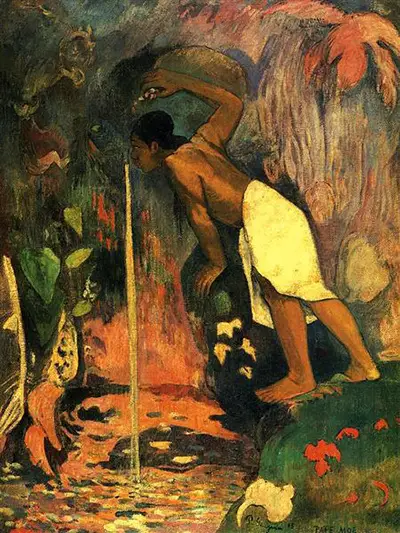The painting shows a young man taking a pose to drink water coming from a mysterious source. A gush of water can be seen rushing down a few centimetres from the man's mouth. He is dressed in a white garment and a bare top. He is also barefooted and seems to step on a stone. He also holds onto other rocks for support, one to his waist-length and another just above his head. He leans forward towards the water source, with his eyes wide open. The surrounding seems forest-like and is magical. According to analysts, the artwork was done with the help of a photograph. The photo captured a young man drinking water from a mysterious water gush. On the canvas, Paul captured the Polynesian landscape and used a Tahitian young male. The water source's mystical feature is that whoever took the water transformed genders, male to female, and vice versa.
The artist uses bright colours to bring his thoughts into life. Carefully looking at the water stream, you can see it begins with a yellow streak, goes to orange, and is golden when it lands on the ground. The surrounding seems to be a secret, and diabolically represents a divine drink. Further looking at the painting, a viewer sees Gauguin's deep knowledge of colour blending where he used extremely bright colours and contrasted them to fit into the environment. It all seems exotic and harmoniously created to accommodate the human figure yearning for the drink. Art analysts feel that Gauguin was trying to portray the Tahitian way of life and how inseparable they were with nature. He told his story in paintings and made the viewers aware of the Tahitian culture.
Paul made this painting during his first Tahitian period. He had just escaped from the European world and found everything in Tahiti fascinating. When he was in Tahiti, he made every painting using Tahitian people. He caught all the elusive and mysterious parts of his new exotic world and transformed them into paintings. Today, the painting sits in the Musee d'Orsay, Paris. Other paintings in this period include Tahitian women, Flowers of France, The Meal, The Ancestors of Tehanama, The Moon and the Earth, Where Are You Going or Woman Holding a Fruit, Day of the God, Two Children, and Child with a Bib.

